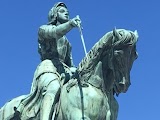As you can imagine, it was a monumental trip. Planning for the Luther leg and Jeanne d'Arc journey were several years in the preparation, identifying accommodations, booking tours and guides in various cities and towns, locating reasonable hotel space, finding the perfect mountain top restaurant from which to view the town of Wartburg, climbing the Fishermen's Bastion in Budapest, viewing Wenceslaus Square and the Astrologic Clock in Prague, and timing the visit to the Eifel Tower so it glittered as we ascend the Metro steps to the Trocadero, these were the many facets of a month "on the continent". They were wonderful moments that will remain in my memory forever.
My friend, Peter, was born in what was known as East Germany, but escaped with his family to live in the west. There were several people at his birthday party who had grown up in the eastern part of the country, the "red" kind, the "communist" side...as we post-World War II kids, thought of them, as we were taught. We knew that the real Evil Empire was located behind that imaginary curtain that separated east and west Europe, friend and foe, democracy and tyranny, goodness and evil. And we knew that the people who lived there were both suffering and brainwashed. But what did they think of us? Surprisingly, they thought the same thing.
 |
Jeanne d'Arc/ Orleans, France
|
But there were other eye-opening moments. The interactions with folks who grew up on the other side, the "evil" side of the infamous "Iron Curtain" was a most interesting part of the trip.
 |
From restaurant at Romantic Hotel in Wartburg
|
Two retired educators, a husband and wife, told us that their jobs depended on tacitly accepting the status quo and how one got along under the rule of the East German puppet government. They shared that even though they were baptized as Christians in the Lutheran Church, neither they nor their parents practiced that faith because to do so would mean your career would suffer and economic hardships, something they all faced, would become more and more unbearable.
And the greyness of the landscape was ever-present. Roads were grey; streets were grey; houses were grey, office buildings were grey; churches were grey; shops and stores were grey; life in general was grey. Food choices were extremely limited. The wait to buy a new state manufactured car was fifteen years; a used one was more expensive than a new one because it was more readily available. There was no unemployment and everyone had a place to live, but housing often came with no heat nor hot water, and the jobs were redundant.
There is still a remnant of this mindset in the local hospitality industry. During this trip I stayed in five hotels/inns located in what we would consider to be behind the "Iron Curtain". It was an experience.
Central European accommodations are sketchy at best. We stayed at world-wide chains and small family owned spots; old world grey ladies and modern hotels retro-fitted into beaux arts buildings near the riverfront. But one thing sort of stuck out: a radically different welcome is needed. A few suggestions follow:
1. Have a list of nearby interesting sights/museums/shops to offer guests; special pricing or discounts are a plus.
2. Recommend and call local restaurants to check on availability. Know their price point as well.
3. Have a taxi service on call.
4. Make sure you have at least one (BBC would work) English language station in your cable offerings. I do not mind Al Jazeera English, but others do.
5. Keep your in-house restaurant/bar open and available for your guests.
6. Know where the closest post office, ATM, cash exchange, bank and hospital are located and how to get there easily.
7. Offer a space for local artisans to display and sell their wares.
8. Have coffee/tea making opportunities in the room; a refrigerator is a plus.
9. Have comfortable lobby seating.
10. SMILE!!!!!
Go to Central Europe...it is reasonable priced and lovely. The people are warm and the sights are interesting.